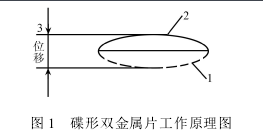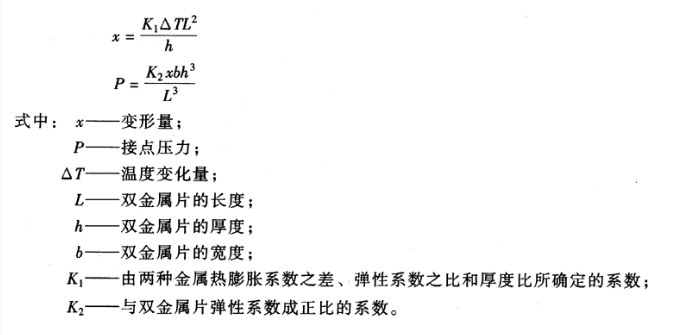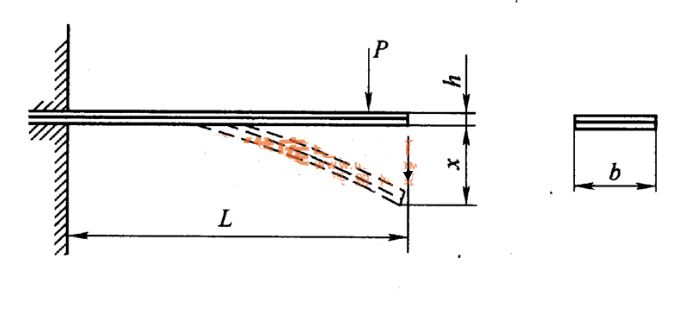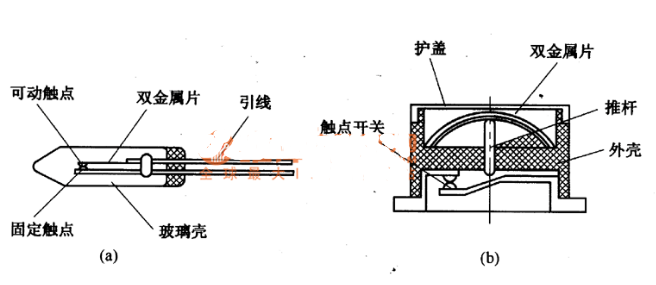A temperature relay is a device that activates when the ambient temperature reaches a specific set point. This product is a contact-type, inductive sealed temperature relay, known for its compact size, lightweight design, high-precision temperature control, and versatility. It is widely used across various industries, including aerospace, surveillance cameras, motors, and electrical equipment, for both temperature regulation and overheat protection.
**How the Temperature Relay Works**
The core component of the relay is a bimetallic strip, made by firmly bonding two metals or alloys with significantly different thermal expansion coefficients. When the temperature rises to a certain level, the metal with the higher expansion coefficient expands more than the other, causing the bimetal to bend upward. This bending motion can then be used to move an electrical contact, either closing or opening the circuit. When the temperature drops below the set point, the bimetal cools down and gradually returns to its original shape, allowing the contacts to return to their original position. The working mechanism of the disc-shaped bimetal is illustrated in Figure 1. At room temperature (state 1), it remains flat. When heated or cooled, it shifts to state 2, resulting in displacement 3.

In the aviation industry, temperature relays are similar in function to those used in civilian applications. However, they must endure extreme environmental conditions and complex system structures. As a result, aviation-grade temperature relays undergo rigorous testing and are manufactured using high-performance materials. These relays must pass a series of environmental tests, such as humidity, mold, vibration, acceleration, impact, and low-pressure conditions. They also require long-term stability and durability, ensuring a service life that matches the lifespan of the equipment they are installed in.
**Structure and Working Principle of Bimetal Temperature Relay**
In a bimetal temperature relay, the bimetal is created by laminating two metals with different thermal expansion coefficients through a rolling process. When heated, the bimetal bends due to the differing rates of expansion. This deformation is used to trigger the switching mechanism, either closing or opening the electrical circuit.
Common materials used for bimetals include nickel-iron alloys and brass, which offer good flexibility and ensure accurate temperature control and repeated use.
The amount of deformation and the contact pressure of the bimetal are determined by the following formulas (see figures):


**Bimetal Parameter Map**
This diagram shows the structure of a bimetal temperature relay. In Figure (a), the relay consists of a bimetal, a movable contact, a fixed contact, a glass enclosure, and leads. When the bimetal reaches the set temperature, it deforms, causing the movable contact to separate from the fixed contact, thus acting as a temperature-controlled switch. In Figure (b), the relay includes a bimetal, a push rod, a contact switch, and a housing. Normally, the contacts are closed. When the bimetal heats up and deforms, the push rod moves downward, opening the contacts and functioning as a temperature switch.

**Bimetal Temperature Relay Structure Diagram**
Temperature relays, also known as temperature controllers, are essential in systems requiring automatic temperature regulation. They are commonly found in household appliances like heaters, microwave ovens, electric water heaters, water dispensers, dishwashers, sterilizers, and dryers. Beyond temperature control, they can also serve as thermal overload protection devices, making them valuable in industrial electronics and automation systems.
D-Subminiature Connectors
The D-subminiature or D-sub is a common type of electrical connector. They are named for their characteristic D-shaped metal shield. When they were introduced, D-subs were among the smallest connectors used on computer systems.
A D-sub contains two or more parallel rows of pins or sockets usually surrounded by a D-shaped metal shield that provides mechanical support, ensures correct orientation, and may screen against electromagnetic interference. The part containing pin contacts is called the male connector or plug, while that containing socket contacts is called the female connector or socket. The socket's shield fits tightly inside the plug's shield. Panel mounted connectors usually have threaded nuts that accept screws on the cable end connector cover that are used for locking the connectors together and offering mechanical strain relief. Occasionally the nuts may be found on a cable end connector if it is expected to connect to another cable end. When screened cables are used, the shields are connected to the overall screens of the cables. This creates an electrically continuous screen covering the whole cable and connector system.
ANTENK offers one of the most comprehensive lines of high reliability D-Subminiature connectors available for military, avionics, space and high reliability industrial applications.
Features of ANTENK D-Subminiature Connectors
-
Standard density d-subminiature connectors
-
High density d-subminiature connectors, contacts are available as well as several custom and combination versions.
-
All d-subminiature connectors may be manufactured with crimp, solder cup, straight PCB and right angle PCB terminations (except solder cup terminations on High Density configurations).
Ragne of of ANTENK D-Subminiature Connectors
Standard Density solder cup, stamped & formed contact D-subminiature connectors
High Density solder cup, stamped & formed contact D-subminiature connectors
Standard Density solder cup,machined contacts D-subminiature connectors
High Density solder cup,machined contacts D-subminiature connectors
crimp & load D-subminiature connectors
IDC D-subminiature connectors
Standard Density vertical mount D-subminiature connectors
High Density vertical mount D-subminiature connectors
Standard Density right angle D-subminiature connectors
High Density right angle D-subminiature connectors
surface mount D-subminiature connectors
Slim D-sub series
D-subminiature connectors stacked D-sub series
D-Subminiature Connectors
ShenZhen Antenk Electronics Co,Ltd , https://www.antenk.com